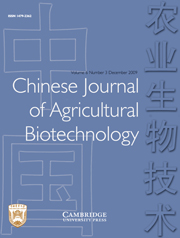Article contents
Identification of polymorphism in the goat callipyge gene (CLPG) and its associations with production traits
Published online by Cambridge University Press: 29 January 2010
Abstract
The Dorset ram of the callipyge phenotype presents with muscular hypertrophy in the buttocks, and its inheritance is polar overdominant. A partial DNA fragment of 250 bp was obtained from the goat (Capra hircas) callipyge gene (CLPG; GenBank accession no. EU753362), which shared 96.04% and 88.65% identity with the corresponding regions of ovine (Ovis aries) and porcine CLPG, respectively. A polymorphism in the DNA fragment was detected by polymerase chain reaction single-strand conformation polymorphism (PCR-SSCP). Sequencing results indicated no A→C mutation corresponding to the ovine CLPG gene, although one A→C transversion was located 147 bp downstream from the CLPG site. The polymorphism, named SNP216 after its position (where SNP indicates single-nucleotide polymorphism), was investigated in Boer (n=63), Laiwu Black (n=70), Lubei White×Boer Hybrid (n=40), Lubei White (n=29) and Inner Mongolia Alashan White cashmere (n=115) goat populations. The results indicated that allele A was dominant in four of the goat populations, the Inner Mongolia Alashan White cashmere goats being the exception. The first four populations were in a state of Hardy–Weinberg equilibrium (P>0.05). In Inner Mongolia Alashan White cashmere goats, least-square means of birth weight, production of cashmere and body weight gain from birth to weaning did not differ significantly between the AA and AC phenotypes (P>0.5).
- Type
- Research Papers
- Information
- Copyright
- Copyright © China Agricultural University 2009
References
- 1
- Cited by


